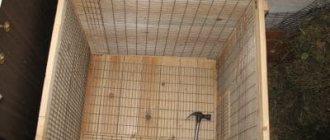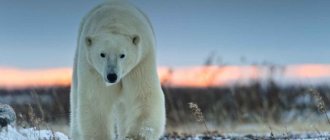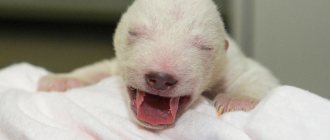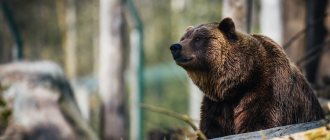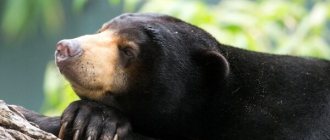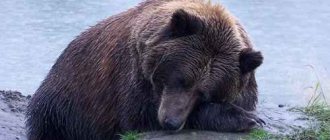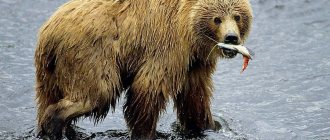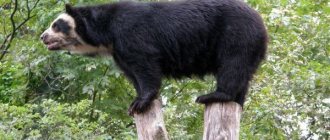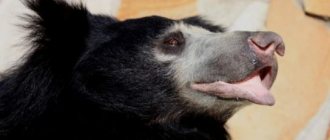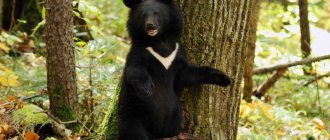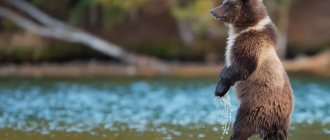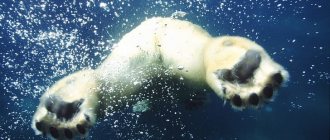Causes of hibernation in bears
The main reason why a bear sleeps in winter is the lack of food in the required amount and difficulties in obtaining it. Being a predator, the bear consumes a lot of vegetation, including berries, roots, and nuts. With the onset of winter, plant foods are practically eliminated from the diet, and it is difficult for the animal to hunt in deep snow. That's why brown bears sleep in winter.
Sleep contributes to the economical use of fat reserves, which are actively “filled up” during the summer, especially in its last weeks, and in the first weeks of autumn. During the season, up to 15 cm of fat is built up, both white and special brown, which has a greater energy reserve.
The following reasons contribute to the fact that bears go to bed in winter:
- The adipose tissue accumulated over the summer and the liver contain a special substance - tocopherol, which slows down the metabolism.
- Serotonin, which accumulates in the brain, also contributes to a decrease in metabolism. As a result, the activity of the nervous and endocrine systems and the entire metabolism decreases, and heat production decreases. The animal's overall body temperature decreases slightly, to 31–34 °C, which ensures light sleep and the ability to wake up at a dangerous moment.
- A bear falls asleep in a den also due to the microclimate conditions that develop there (the oxygen content decreases, and the carbon dioxide content, on the contrary, increases, the air temperature drops).
In northern latitudes, food for bears is abundant throughout the year; there are no long periods of hunger and the need for animals to enter a state of economical mode. Polar bears also sleep if there are difficulties in catching fish, but not for long, on the move, very sensitively.
Bear den, its structure
The den serves not only as a shelter - it creates the necessary microclimatic conditions. The bear sleeps in its den from the end of November to the end of March–mid-April, a total of 5-6 months. How long a bear sleeps is influenced by the climate zone, gender and age of the animal.
In northern latitudes, most dens are dug in the ground, located on the slopes of ravines, dry streams, in impassable places - where there is a lot of windfall or next to impassable swamps.
Clubfoots dig their home for two or three days. The den consists of an entrance (brow), a hole and a place for lying down, the so-called den chamber. The roof is a layer of earth penetrated by the roots of various plants, which helps strengthen the earthen canopy and retain heat. Air access to the den is carried out through a hole that remains open even under the snow.
The floor is covered with bedding - dry grass, spruce branches, wood chips, moss. The further north the habitat is, the greater the layer of litter. In female bears, it serves as protection for future cubs, keeping them warm and preventing accidental squeezing, since it is springy. Therefore, females make it somewhat thicker than males.
Clubfoots living further south can go to sleep for the winter on the surface in secluded places - under snags, wide spreading paws of spruce trees, near an inverted stump.
What happens to a bear during winter sleep
When a bear goes to sleep for the winter, it does not enter into suspended animation, with the suspension of all life processes, like amphibians. Physiological processes in a brown sleeping bear only slow down. Heartbeat and breathing become less frequent, and body temperature decreases by 3-4 degrees. Sleep remains quite sensitive; even a slight noise can interrupt it.
The bear does not eat anything or drink water all winter, and does not recover and does not urinate. His body exists due to the oxygen supplied through respiration and the energy obtained from the breakdown of fat reserves, from which carbon dioxide and water are formed.
During the entire period of hibernation, a fecal plug forms in the intestines. In the spring, after the bear leaves the den, she soon comes out. Urea, which is constantly formed in the kidneys, is used by the body of a sleeping animal to create new proteins. Therefore, the wounds of an animal in hibernation heal well, the fur does not fade, and the muscle and bone tissue do not atrophy from lack of movement.
The male sleeps all winter, turning daily. The she-bear is experiencing an important event - the birth of her cubs.
The bear mating season occurs at the end of summer, but the fertilized cells do not develop immediately, they pause. With the onset of cold weather, at the end of November, the egg cell fertilized at the beginning of summer is attached and its further development occurs. Pregnancy lasts 2 months, and cubs are born in January. At the moment of birth, the bear wakes up from her slumber, and then falls asleep again.
Newborn cubs are tiny, weigh no more than 350–400 grams, have no fur, are blind and have no teeth. They feed on their mother’s fatty milk, being in the warmest places of the bear’s body, because her nipples are located in the armpits and inguinal cavities.
By the time they emerge from hibernation, the cubs weigh about 5 kg and already have good fur. They are under the protection of their mother in summer and autumn. At the end of November, the bear goes back to sleep in the den with the grown cubs. For the third hibernation, they themselves, without their mother, look for winter shelter.
Features of character and lifestyle
The polar bear is considered a cruel predator that even attacks people. The animal prefers a solitary lifestyle; males and females gather together only during the rutting period. The rest of the time, bears move exclusively through their own territory, conquered from their other brothers, and this applies not only to males, but also to females with newborn offspring.
Hibernation
Unlike its brown counterparts, the polar bear does not have to hibernate for the winter. Most often, only pregnant females sleep on the eve of giving birth. Adult males do not sleep every season; the duration of hibernation is no more than 80 days (a brown bear sleeps from 75 to 195 days a year).
Reproduction of polar bears, care of offspring
Polar bears behave quite peacefully towards each other; most fights occur between males during the rutting period. At this time, not only adult animals can suffer, but also cubs, which prevent the female from re-participating in mating games.
Animals become sexually mature when they reach 4 or 8 years of age, while females are ready to bear offspring 1-2 years earlier than males.
The mating season lasts from late March to early June. One female can be pursued by up to 7 males. Gestation of offspring takes at least 250 days, which corresponds to 8 months. Pregnancy begins with a latent stage, which is characterized by a delay in embryo implantation. This feature is associated not only with the physiology of the animal, but also with its living conditions. The female must prepare for fetal development and long hibernation. Around the end of October, she begins to equip her own den, and for this purpose sometimes travels hundreds of kilometers. Many females dig dens near existing buildings. Thus, on the Wrangel and Franz Josef islands there are at least 150 closely located dens.
Embryo development begins in mid-November, when the female is already sleeping. Its hibernation ends in April and at about the same time 1-3 cubs, weighing from 450 to 700 grams each, appear in the den. The exception is the birth of 4 cubs. The babies are covered with thin fur, which practically does not protect them from the cold, therefore in the first weeks of their life the female does not leave the den, maintaining her existence at the expense of accumulated fat.
Newborn cubs feed exclusively on mother's milk. They do not open their eyes immediately, but a month after birth. Two-month-old babies begin to crawl out of the den, only to leave it completely when they reach 3 months. At the same time, they continue to feed on milk and stay close to the female until they reach 1.5 years. Small cubs are practically helpless, so they often become prey for larger predators. The mortality rate among polar bears under 1 year of age is at least 10-30%.
A new pregnancy in a female occurs only after the death of the offspring, or their introduction into adulthood, that is, no more than once every 2-3 years. On average, no more than 15 cubs are born from one female during her entire life, half of which die.
This is interesting: What size was the largest white shark?
Bears sleep outside of hibernation
In the spring, after waking up, the animal stays near the den for some time, returning to sleep there within one week. Then he sleeps more and more often in the forest, in a so-called bed or bed. The bed is built in a depression in the snow - this is a flooring made of dry branches, moss, and wood chips.
Closer to summer, the bed changes, it becomes a hole dug in the ground, into which the clubfoot is placed, like in a chair, with its hind legs and belly, and it places its front legs and muzzle on its edge. One bear may have several such beds. In spring and autumn, beds have bedding and retain heat; in summer they are damp and cool, increase heat transfer and facilitate thermoregulation of the animal’s body.
In the spring, after waking up, the clubfoot actively spends the day, he is playful and active, but eats practically nothing except pine needles, which puts his digestive system in order within one to two weeks. Then comes a period of active feeding - the bear spends most of the day collecting food.
The bear does not have a clear sleep schedule during the warm season; he goes to bed both during the day and at night. How often and how long the animal goes to sleep in the summer depends on the amount of available food and the volume of accumulated fat as a reserve for the next winter. At night, the bear is more often awake, preferring to sleep during the day.
How do polar bears sleep, the differences between their sleep
When asked whether polar bears, like their brown relatives, also sleep for a long time, the answer is no. There is enough food for them all year round, so there is no need to enter a long-term energy saving mode.
If there is a problem with food, the polar bear saves energy on the move - its metabolism and the work of all organs slow down, the processing of urea is turned on with the formation of new proteins. But at the same time, wakefulness and even the ability to move are preserved. The beast only becomes somewhat inhibited. When food appears, he comes out of this state and begins to hunt.
Every day the bear sleeps for several hours, and, taking into account the peculiarities of the length of daylight hours in northern latitudes (polar day and polar night), polar bears go to bed arbitrarily, without having a clear routine.
The polar bear sleeps wherever it can, mainly choosing places where snow drifts form dunes. Curling up, he turns his back to the wind. During a snowstorm, snow completely covers the animal's body in a dense layer, providing it with thermal protection. This is how bears spend the night.
A polar bear goes to bed for a long time with the main goal of giving birth to and feeding cubs. In dense snow, often near the coastline, it digs a den. The shelter has a hole and a main chamber, sometimes there are several chambers. The snow den retains heat well, and ventilation is provided through a special hole.
After 1.5–2 months, the female gives birth to cubs. Usually there are no more than three. After the end of the polar night, in March or a little later - in April, hibernation ends. By this time, the cubs have dense fur and are able to eat food obtained by their mother. The mother bear continues to care for the cubs until they are two years old, then they go their separate ways.
Where do bears live?
Polar bears prefer to live on the northern shores and borders of warm northern currents.
This animal lives mainly on the shores of the island of Greenland, the islands of Spitsbergen, on some lands in the Barents Sea, on the islands of Vaigach, Kolguev and Medvezhiy, as well as near the Kara Sea.
Also, many individuals of this species live off the coast of the Laptev Sea, the Chukchi Sea and the East Siberian Sea. The favorite habitat of polar bears is the coastal part of the Arctic Ocean.During pregnancy, females look for a secluded place, wintering in dens. To do this, they choose their main habitats: northern Greenland, small islands of the Kara Sea, the Spitsbergen archipelago, the northern coast of Taimyr Island and other small islands and lands of the Barents Sea.
Dens are also found on the ice of Beaufort. Sometimes in early spring, female bears can move towards the Scandinavian countries, Kamchatka and the Gulf of Anadyr. On ice floes, animals can get into the Sea of Okhotsk and the Sea of Japan.
Sleeping bears in the zoo
Despite the fact that in zoos food is delivered to animals uninterruptedly, the furry animals still go to bed for the winter months. This applies to black, brown and Himalayan bears. Their biological clock is triggered. Lack of hibernation can lead to obesity. Zoo staff are trying to create all the necessary conditions for the clubfooted animals to go to sleep.
In artificial dens (specially equipped rooms), bears make beds for themselves from branches, wood chips, and shavings. They wake up, as in the wild, at the end of March–mid-April.
In the zoo, male polar bears do not sleep, and females rarely go to bed for the winter. With the onset of cold weather, the decrease in the amount of food and the deterioration of conditions for obtaining it are the main reason for winter sleep. How long bears sleep in winter depends on the climate zone and the duration of winter. They sleep lightly and are not difficult to wake up. Physiological processes in the body of animals slow down and have unique features. During this period, females give birth and grow cubs.
They're not quite white
Polar bears' fur is transparent, with a hollow core and microscopic bumps that scatter light. When light rays are reflected inside the hollow hair shafts, they create luminescence, producing a whitish hue. Which explains the appearance of the polar bear.
Another factor influencing white color is keratin. A type of protein found in human hair and nails. Keratin is also found in the animal kingdom, usually in hooves and horns. But in polar bears, keratin is present in their outer layer of hair, which is whitish in color. Of course, this allows them to blend in with their surroundings of snow and ice.
Moreover, polar bears actually have dark skin. This helps animals absorb heat from the sun and provides protection from harmful ultraviolet rays. Interestingly, polar bears are born with a pink tongue, which eventually develops black spots. Their inner cheeks and upper mouth are also dark.
